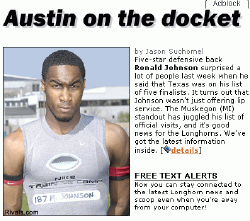Those interested in the newspaper/media business will do well to read a story published in the New York Times yesterday about the Rivals sports network.
![]() Rivals maintains a website for every large college in the country and has 1-4 reporters dedicated to covering each school’s athletic department in depth (many of the reporters are part timers who have other jobs). There is no print product. These team sites provide insider news as well as in deptch football, baseball and basketball recruiting news. This kind of reporting isn’t really done by the mainstream media. In addition to the news, as a subscriber you also get access to a private, team-specific bulletin board where the reporters interact with the subscribers.
Rivals maintains a website for every large college in the country and has 1-4 reporters dedicated to covering each school’s athletic department in depth (many of the reporters are part timers who have other jobs). There is no print product. These team sites provide insider news as well as in deptch football, baseball and basketball recruiting news. This kind of reporting isn’t really done by the mainstream media. In addition to the news, as a subscriber you also get access to a private, team-specific bulletin board where the reporters interact with the subscribers.
Rivals charges $9.95 per month for access to the website for a single team (such as the University of Texas). According to the Times article, Rivals has 160,000 paying subscribers. Assuming each user is paying an average of $9.95 per month, that would mean Rivals is clearing a little over $19 million a year just on subscriptions.
 I would guess total revenue is actually much, much higher than that. Rivals sells team merchandise. Many subscribers undoubtedly maintain subscriptions to the sites of multiple teams. And Rivals sells ad space on their sites as well. The ad revenue could be significant considering that Rivals claims to have attracted 57 million page views on a single day last year (national football signing day).
I would guess total revenue is actually much, much higher than that. Rivals sells team merchandise. Many subscribers undoubtedly maintain subscriptions to the sites of multiple teams. And Rivals sells ad space on their sites as well. The ad revenue could be significant considering that Rivals claims to have attracted 57 million page views on a single day last year (national football signing day).
Rivals isn’t the only group making money off of in depth sports coverage. The Dallas Morning News runs a similar service covering the Dallas Cowboys called Cowboys Plus. They charge folks to get access to leftovers from the print coverage, video, reporter/columnist blogs and a weekly insider style newsletter. I have no idea how many subscribers they have. But given the obsessive nature of Cowboy fans, I’d bet the service is doing well.
I think the model used by Cowboys Plus and Rivals is one that can be applied by newspapers and other mainstream media organizations to topics beyond sports. The way I see it there are three main pieces to the formula:
(1) Cover the hell out of a topic people care intensely about. The Austin American Statesman isn’t going to churn out three stories a day about the football recruiting efforts of the University of Texas football team. And Wired Magazine isn’t going to churn out eight stories a day about tech gadgets the way Engadget does. There is a great market for providing in depth coverage of niche content.
(2) Have the reporters interact with subscribers on a daily basis. For many subscribers to the Rivals service, having access to the private discussion boards is more important than the content produced. They want to discuss their team with fellow fanatics and interact with the reporters covering their team.
(3) Turn your subscribers into citizen journalists/columnists. The Rivals sites have a cadre of loyal and passionate subscribers. Many of the subscribers have relationships with players and members of the coaching staff and end up breaking their own news on occasion. Others are frustrated sports writers who have a way with words and an encyclopedic knowledge of their team. Getting access to the thoughts of other subscribers is an important part of the Rivals model.
Will this model work for non-sports related topics?
Absolutely. Sites like Techcrunch and Engadget provide in depth coverage of the Web 2.0 and gadgets markets and make plenty of money through an advertising model as opposed to a subscription one. But the formula for these sites is actually very similar to that of the sports sites.
Find an under served topic and cover it better than anyone else. Post lots of content and do so in real time. Interact with your users and turn your site into a community.
Sign up today to have our latest posts delivered straight to your inbox.